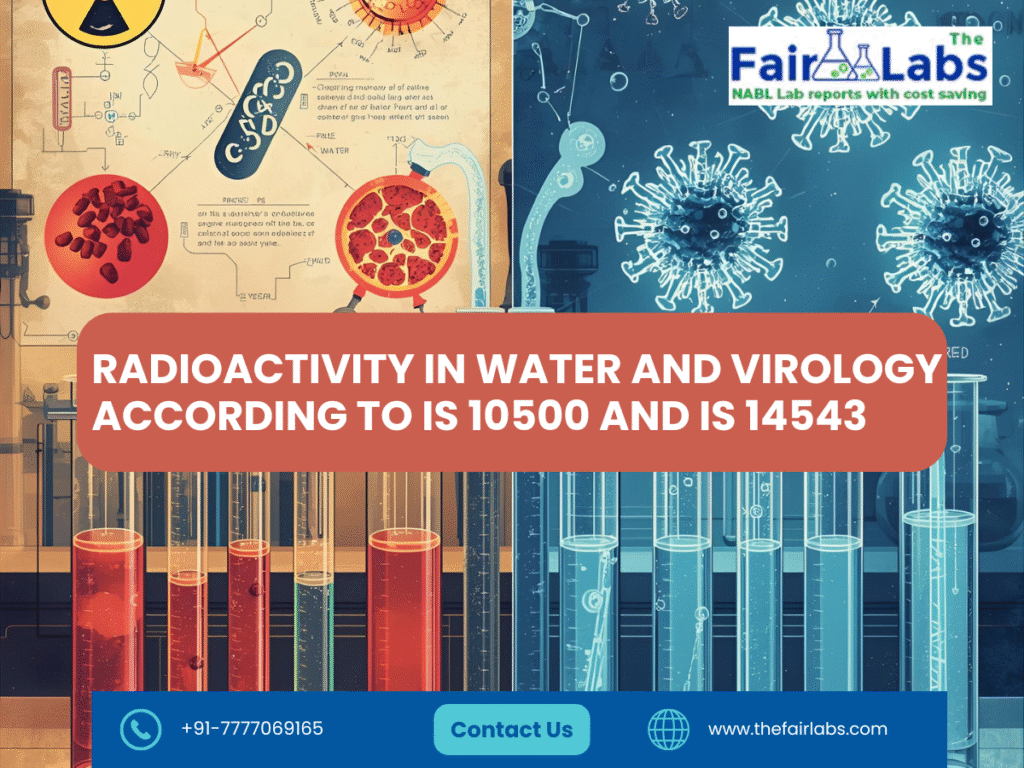Safe drinking water is a vital public health concern in India. There are two influential standards that oversee water quality: IS 10500, which addresses drinking water quality for drinking purposes, and IS 14543, which lays down requirements for packaged drinking water. These standards, formulated by the Bureau of Indian Standards (BIS) and FSSAI, address principal parameters like chemical safety, microbial quality, radioactivity, and virology.
In this article, we shall discuss water radioactivity and virology according to IS 10500 and IS 14543, present the discrepancies between IS 10500 vs IS 14543, and illustrate why adherence to BIS Standard Packaged Drinking Water IS 14543 is necessary.
Importance of Water Quality Standards
Water is also termed the elixir of life, but contaminated water can become a vehicle for pathogenic microorganisms, viruses, and radioactive materials. In the absence of regulation, impure water may spread diseases like cholera, typhoid, viral hepatitis, and even long-term illnesses like cancer through radioactive material exposure.
For protecting public health, the FSSAI has established compulsory standards to guarantee piped drinking water (IS 10500) and BIS has established IS 14543 for packaged drinking water.
What is IS 10500?
Issued by FSSAI, IS 10500 is the drinking water quality standard distributed through pipelines, borewells, and other sources for domestic use. It specifies:
- Acceptable parameters for chemical, physical, and biological.
- Limits for radioactivity in order to avoid exposure to dangerous radioactive isotopes.
- Virological and microbiological standards to make sure water is free from infectious bacteria and viruses.
The standard makes sure water consumed on a daily basis fulfills the safety standards required to eliminate health risks.
What is IS 14543?
IS 14543 is the BIS specification for packaged drinking water (bottled water). Any organization selling packaged water in India needs to be covered by this standard. It specifies:
- Treatment processes like filtration, disinfection, and reverse osmosis.
- Packaging standards to prevent contamination.
- Virology and radioactivity parameters similar to IS 10500 but stricter due to commercial distribution.
In short, IS 14543 ensures that packaged water bottles available in the market are free from harmful microorganisms and radioactive contaminants.
IS 10500 vs IS 14543 – Key Differences
When comparing IS 10500 vs IS 14543, both aim to ensure safe water but serve different purposes.
| Parameter | IS 10500 (Drinking Water) | IS 14543 (Packaged Drinking Water) |
| Purpose | Norms for safety of water supplied for domestic use | Regulates bottled/packaged drinking water safety |
| Applicability | Household water, municipal supply, borewell, Ingredient in any food product, raw material in factory | Packaged water sector and bottled water plants |
| Radioactivity Check | Must be done | Must be done (more stricter) |
| Virology & Microbiology | Should be free from infectious bacteria and viruses | Should be totally safe, batch-wise tested |
| Packaging Standards | FSSAI standard applicable | BIS standard applicable |
Therefore, whereas IS 10500 provides safe supply at the national level, BIS Standard Packaged Drinking Water IS 14543 governs commercially bottled water supplied in the market.
Water Radioactivity according to IS 10500 and IS 14543
Radioactivity of water is caused by natural geological structures or industrial contamination. Even small quantities of radium, uranium, and other isotopes are dangerous if ingested over time.
- IS 10500 lays down limits for alpha and beta emitters in potable water.
- IS 14543 requires more stringent testing for packaged water so that the commercial bottled water is safe prior to consumption.
This averts long-term hazards like cancer, bone impairment, and organ failure.
Water Virology according to IS 10500 and IS 14543
Viruses are some of the most lethal impurities in water. Water viruses such as Hepatitis A, Rotavirus, and Enteroviruses have the potential to lead to epidemic outbreaks.
- According to IS 10500, water should be analyzed for total coliform, E. coli, and viral pathogens. Virological parameters include Coliphage, Algae, Zooplanktons, Flagellates, MS 2 Phase.
- According to IS 14543, each packaged water batch should be tested microbially and for virology to confirm the absence of disease-causing organisms.
This ensures household supply water and bottled water both are virologically safe.
Why Compliance is Important
IS 10500 and IS 14543 are not guidelines but essential protections. Compliance guarantees:
- Public health safety – Prevents waterborne diseases.
- Consumer confidence – Packaged water certified provides assurance to consumers.
- Legal safeguarding – Non-compliance can result in fines or prohibition.
- Sustainability – Promotes safe water habits at all levels.
BIS Standard Packaged Drinking Water IS 14543 – A Closer Look
The BIS Standard Packaged Drinking Water IS 14543 entails:
- Selection and testing of the water source.
- Treatment processes like UV disinfection, reverse osmosis, and ozonation.
- Daily testing of physical, chemical and microbiological parameters inhouse.
This ensures that each bottle sold to the consumer is strictly safe.
Consumer Awareness – What You Should Know
You, as a consumer, ought to know these standards:
- Verify FSSAI Certification Mark on packaged water bottles.
- Verify municipal or borewell water in your neighborhood is tested according to IS 10500.
- Avoid unbranded bottled water that does not comply with FSSAI mark
- Understand the health hazards of radioactive or virus-infected water.
Conclusion
Water safety is not negotiable. IS 10500 (quality of drinking water) and IS 14543 (standard of packaged drinking water) are both essential in guarding public health. While IS 10500 is responsible for governing the quality of piped and household water, BIS Standard Packaged Drinking Water IS 14543 guarantees each packet water bottle complies with the highest safety standards of radioactivity and virology.
For both consumers and businesses, adherence to and awareness of these standards are not only a matter of law but also a civic duty.

